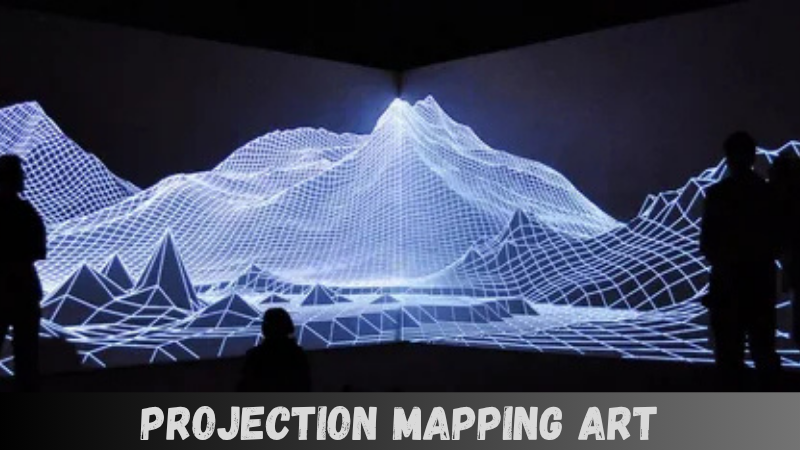Introduction
In the world of modern art, few technologies are as mesmerizing as projection mapping art. By using light and motion to animate physical surfaces, artists can create illusions that make buildings breathe, sculptures move, and entire rooms come to life. Unlike traditional static displays, projection mapping art blends digital design with architecture, storytelling, and interactivity to deliver a jaw-dropping experience. In this article, we’ll explore what projection mapping is, how it works, and why it’s become a global phenomenon in art, entertainment, and public events.
What Is Projection Mapping Art?
To begin with, projection mapping art is a digital technique where video or light is projected onto irregular surfaces—such as buildings, statues, or landscapes—in a way that aligns perfectly with the object’s shape. Unlike projecting onto a flat screen, this method “maps” the projection to the geometry of the surface, transforming everyday objects into dynamic displays.
Consequently, a cathedral can shimmer with fire, a mountain can tell a story, or a museum facade can crumble and rebuild itself in a dazzling illusion. In short, it turns the physical world into a canvas for light, animation, and creative storytelling.
The Process Behind Projection Mapping Art
Creating a projection mapping art installation requires a combination of artistic vision and technical precision. Typically, the process includes the following stages:
- 3D Scanning or Modeling – The object or building is digitally mapped to determine its shape and dimensions.
- Content Creation – Artists design visuals, animations, and effects that complement the object’s surface.
- Software Calibration – Specialized software (like Resolume, MadMapper, or TouchDesigner) is used to align the projection with the object.
- Setup and Testing – Projectors are installed, and content is tested to ensure perfect alignment.
- Performance or Looping Display – Finally, the completed work is shown as a timed event, looping experience, or interactive installation.
Altogether, this fusion of technology and creativity allows artists to play with perception, depth, and motion in ways never before possible.
Notable Examples
Across the globe, projection mapping art has been used to light up historic landmarks and captivate audiences. Consider these remarkable examples:
- “AURA” at Notre-Dame Cathedral (Paris) – A breathtaking projection mapping show that brings centuries-old architecture to life with vivid animations and light.
- Tokyo Station’s “Tokyo Michiterasu” – A large-scale visual experience blending Japanese tradition with futuristic digital imagery.
- Disney’s “Happily Ever After” (Magic Kingdom) – The iconic castle becomes a living, animated backdrop perfectly synchronized with music and fireworks.
Clearly, these installations showcase the versatility and impact of projection mapping art—from storytelling to pure visual spectacle.

Where Projection Mapping Art Is Used Today
- Art festivals and museums rely on it to create immersive exhibitions.
- Concerts and stage productions use it to transform backdrops into moving, responsive visuals.
- Retailers and brands deploy it in pop-up shops, product launches, and advertising to draw attention and create memorable moments.
- Public celebrations and holidays often feature projection mapping on iconic buildings to entertain large crowds.
As a result, projection mapping has grown from an experimental tool to a mainstream artistic and commercial medium.
Why Audiences Love This Art
For one, it brings magic to the familiar. Buildings we pass every day become vibrant, animated stories. Moreover, it creates a shared experience—something people enjoy together, whether at a festival, city square, or museum.
Additionally, the format is accessible and engaging. It doesn’t require any special knowledge or artistic background to appreciate. Instead, it invites everyone to stand still, look up, and feel something powerful.
Future
Looking ahead, the potential of projection mapping art continues to expand. As technology becomes more advanced and affordable, the art form is becoming even more creative and inclusive. Future trends may include:
- AI-driven projections that adapt to the crowd’s mood or movement.
- Interactive layers combining projection with AR or VR for deeper immersion.
- Eco-conscious setups using solar-powered or low-energy projectors.
- Wearable tech enabling individuals to control elements of the experience.
Undoubtedly, projection mapping will play a key role in the evolution of immersive, tech-enabled art.
Conclusion
In conclusion, projection mapping art has transformed how we view public spaces, objects, and architecture. By fusing technology with creativity, artists can make walls move, ceilings breathe, and monuments speak. Whether used to tell a story, enhance a concert, or spark curiosity in everyday settings, this form of art illuminates both the imagination and the environment.
FAQ
Q1: What makes projection mapping different from traditional projection?
A: Traditional projection is typically shown on a flat surface, like a screen. In contrast, projection mapping aligns content to 3D surfaces, making the visuals appear as if they are part of the object—bringing it to life.
Q2: What tools are needed to create projection mapping art?
A: Artists usually need a projector, 3D modeling software, mapping tools (e.g., MadMapper, Resolume), and often audio and lighting equipment for full effect.
Q3: Is projection mapping expensive to implement?
A: It can be, especially for large-scale displays. However, with more affordable tech options now available, smaller installations are becoming accessible to individual artists and local event planners.
Q4: Can projection mapping be interactive?
A: Yes! Many installations use sensors or motion detection to respond to audience movement, making the experience unique to each participant.
Q5: Where can I view projection mapping art?
A: Look for it at light festivals, museums, concerts, or public celebrations in major cities. It’s often featured on buildings, sculptures, and even entire landscapes.
You can also read this : Interactive Light Art: Where Technology Illuminates Creativity
